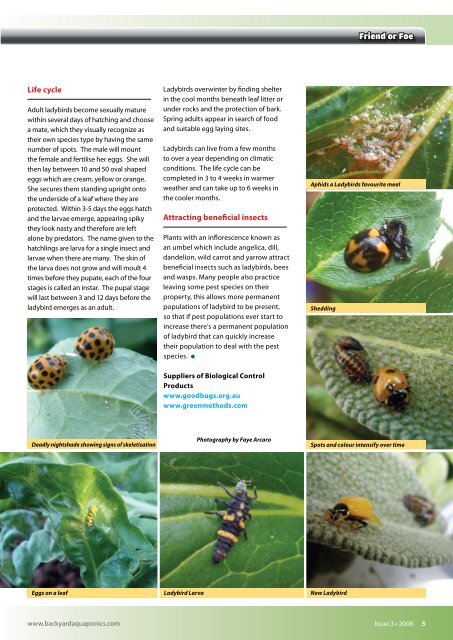Keeping Trout - Backyard Magazines
Keeping Trout - Backyard Magazines
Keeping Trout - Backyard Magazines
You also want an ePaper? Increase the reach of your titles
YUMPU automatically turns print PDFs into web optimized ePapers that Google loves.
Life cycle<br />
Adult ladybirds become sexually mature<br />
within several days of hatching and choose<br />
a mate, which they visually recognize as<br />
their own species type by having the same<br />
number of spots. The male will mount<br />
the female and fertilise her eggs. She will<br />
then lay between 10 and 50 oval shaped<br />
eggs which are cream, yellow or orange.<br />
She secures them standing upright onto<br />
the underside of a leaf where they are<br />
protected. Within 3-5 days the eggs hatch<br />
and the larvae emerge, appearing spiky<br />
they look nasty and therefore are left<br />
alone by predators. The name given to the<br />
hatchlings are larva for a single insect and<br />
larvae when there are many. The skin of<br />
the larva does not grow and will moult 4<br />
times before they pupate, each of the four<br />
stages is called an instar. The pupal stage<br />
will last between 3 and 12 days before the<br />
ladybird emerges as an adult.<br />
Deadly nightshade showing signs of skeletisation<br />
www.backyardaquaponics.com<br />
Ladybirds overwinter by finding shelter<br />
in the cool months beneath leaf litter or<br />
under rocks and the protection of bark.<br />
Spring adults appear in search of food<br />
and suitable egg laying sites.<br />
Ladybirds can live from a few months<br />
to over a year depending on climatic<br />
conditions. The life cycle can be<br />
completed in 3 to 4 weeks in warmer<br />
weather and can take up to 6 weeks in<br />
the cooler months.<br />
Attracting beneficial insects<br />
Plants with an inflorescence known as<br />
an umbel which include angelica, dill,<br />
dandelion, wild carrot and yarrow attract<br />
beneficial insects such as ladybirds, bees<br />
and wasps. Many people also practice<br />
leaving some pest species on their<br />
property, this allows more permanent<br />
populations of ladybird to be present,<br />
so that if pest populations ever start to<br />
increase there’s a permanent population<br />
of ladybird that can quickly increase<br />
their population to deal with the pest<br />
species.<br />
Suppliers of Biological Control<br />
Products<br />
www.goodbugs.org.au<br />
www.greenmethods.com<br />
Photography by Faye Arcaro<br />
Eggs on a leaf Ladybird Larva New Ladybird<br />
Friend or Foe<br />
Aphids a Ladybirds favourite meal<br />
Shedding<br />
Spots and colour intensify over time<br />
Issue 3 • 2008 5


